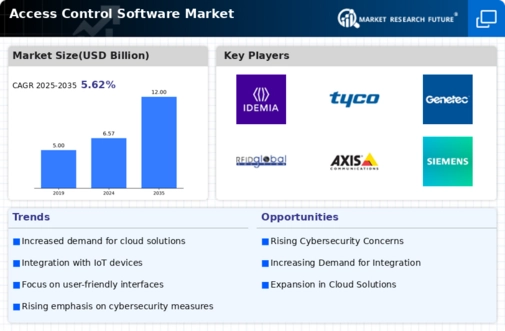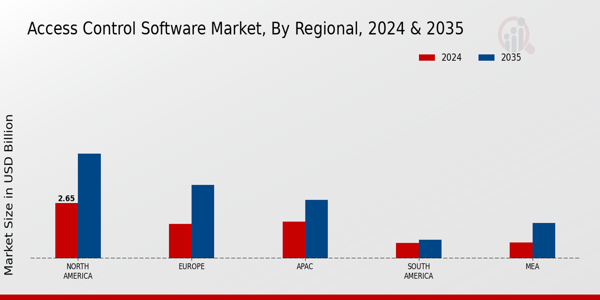Regulatory Compliance
The Global Access Control Software Market Industry is significantly influenced by the need for regulatory compliance across various sectors. Organizations are mandated to adhere to stringent regulations regarding data protection and privacy, which necessitates the implementation of effective access control measures. Compliance with standards such as GDPR and HIPAA drives the demand for sophisticated access control solutions that ensure secure data handling and user authentication. As a result, the market is poised for growth, with a projected CAGR of 5.63% from 2025 to 2035, reflecting the ongoing commitment of organizations to meet regulatory requirements.
Market Growth Projections
The Global Access Control Software Market Industry is projected to experience substantial growth over the next decade. With a market value of 6.57 USD Billion in 2024, it is anticipated to reach 12 USD Billion by 2035. This growth trajectory reflects a compound annual growth rate of 5.63% from 2025 to 2035. Such projections highlight the increasing recognition of access control systems as essential components of organizational security strategies. As businesses continue to prioritize security investments, the market is likely to expand, driven by technological advancements and evolving security needs.
Technological Advancements
Rapid technological advancements play a pivotal role in shaping the Global Access Control Software Market Industry. Innovations such as biometric authentication, mobile access control, and cloud-based solutions are transforming traditional security measures. These technologies not only enhance security but also improve user convenience and operational efficiency. As organizations seek to leverage these advancements, the market is expected to witness significant growth, with projections indicating a value of 12 USD Billion by 2035. This growth underscores the industry's potential to adapt to evolving technological landscapes and meet the demands of modern security challenges.
Increasing Security Concerns
The Global Access Control Software Market Industry experiences heightened demand due to escalating security concerns across various sectors. Organizations are increasingly prioritizing the protection of sensitive data and physical assets, leading to a surge in the adoption of advanced access control solutions. For instance, the rise in cyber threats and unauthorized access incidents has prompted businesses to invest in robust access control systems. This trend is reflected in the market's projected value of 6.57 USD Billion in 2024, indicating a growing recognition of the importance of security measures in safeguarding organizational integrity.
Integration with IoT Devices
The integration of access control systems with Internet of Things (IoT) devices is emerging as a significant driver in the Global Access Control Software Market Industry. As smart buildings and connected environments become more prevalent, the demand for seamless integration between access control solutions and IoT devices is increasing. This integration enhances operational efficiency and provides real-time monitoring capabilities, allowing organizations to respond swiftly to security threats. The growing trend of smart technology adoption is likely to propel the market forward, contributing to its anticipated growth trajectory in the coming years.
Rising Demand from Emerging Markets
Emerging markets are becoming increasingly important for the Global Access Control Software Market Industry, as economic growth and urbanization drive the need for enhanced security solutions. Countries in Asia-Pacific and Latin America are witnessing a surge in infrastructure development, leading to a greater emphasis on access control systems. The expansion of industries such as manufacturing, retail, and healthcare in these regions is expected to fuel demand for advanced access control solutions. This trend indicates a promising future for the market, as emerging economies continue to invest in security technologies to safeguard their assets and operations.























